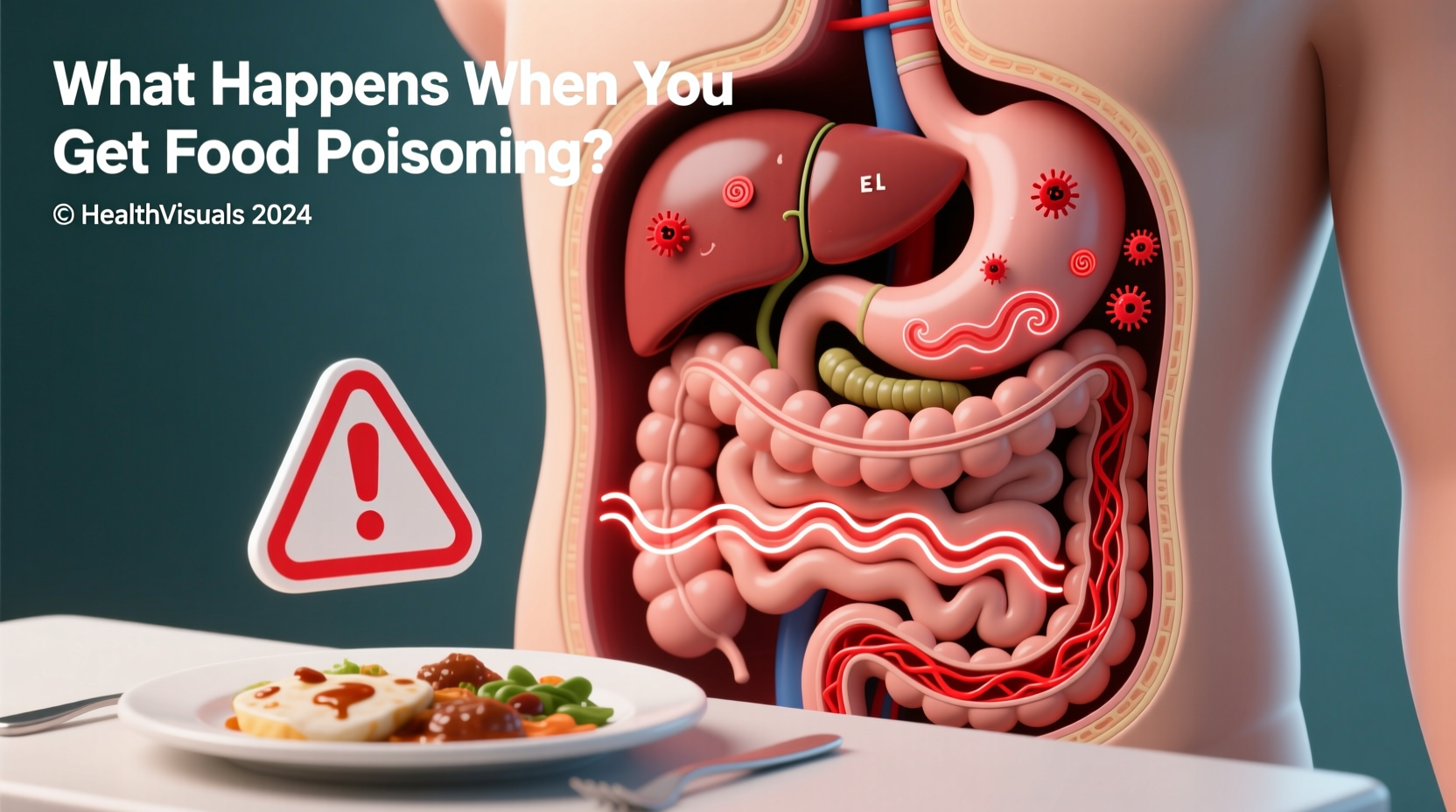Understanding Your Body's Response to Foodborne Illness
Food poisoning triggers a rapid physiological response as your body attempts to eliminate harmful contaminants. Within hours of consuming contaminated food, your digestive system activates defense mechanisms that lead to uncomfortable but protective symptoms. This natural process, while unpleasant, serves a critical purpose in expelling pathogens from your system.
Your Food Poisoning Timeline: Hour-by-Hour Progression
Knowing what happens when you get food poisoning starts with understanding the typical symptom progression. The exact timeline varies based on the contaminant, but most cases follow a predictable pattern:
| Time After Exposure | What's Happening in Your Body | Common Symptoms |
|---|---|---|
| 0-6 hours | Pathogens begin multiplying in digestive tract | None or mild discomfort |
| 6-24 hours | Toxins released, triggering immune response | Nausea, stomach cramps, early diarrhea |
| 24-48 hours | Peak immune response, fluid loss increases | Vomiting, frequent watery diarrhea, fever, dehydration signs |
| 48-72 hours | Pathogen levels decreasing, recovery begins | Symptoms gradually improving, energy returning |
| 72+ hours | Complete elimination of pathogens | Full recovery for most cases |
According to the Centers for Disease Control and Prevention (CDC), approximately 48 million people in the United States get sick from foodborne diseases each year, with most recovering without medical treatment. The body's inflammatory response to pathogens like Salmonella, E. coli, or norovirus causes the characteristic symptoms as your system works to flush out the invaders.
Common Food Poisoning Pathogens and Their Effects
Different contaminants produce varying symptoms and timelines. Understanding which pathogen might be responsible helps anticipate what happens when you get food poisoning:
| Pathogen | Common Sources | Onset Time | Key Symptoms | Duration |
|---|---|---|---|---|
| Norovirus | Raw shellfish, contaminated surfaces | 12-48 hours | Violent vomiting, watery diarrhea, stomach cramps | 1-3 days |
| Salmonella | Raw eggs, poultry, unpasteurized milk | 6-72 hours | Diarrhea, fever, stomach cramps | 4-7 days |
| E. coli | Undercooked ground beef, raw produce | 1-10 days | Severe stomach cramps, bloody diarrhea | 5-10 days |
| Listeria | Deli meats, soft cheeses, unpasteurized dairy | 1-4 weeks | Fever, muscle aches, gastrointestinal symptoms | Variable |
The World Health Organization emphasizes that foodborne pathogens affect vulnerable populations more severely. While healthy adults typically recover from common food poisoning within days, infants, elderly individuals, and those with compromised immune systems face higher risks of complications. The physiological response involves your body increasing gut motility to expel contaminants while triggering inflammation that causes the characteristic cramping and discomfort.
When Food Poisoning Requires Medical Attention
Most cases of food poisoning resolve without medical intervention, but certain warning signs indicate you should seek professional help immediately. The Mayo Clinic identifies critical symptoms that signal potentially serious complications:
- Diarrhea lasting more than 3 days
- Severe dehydration symptoms (extreme thirst, dry mouth, little or no urination)
- Rectal temperature above 101.5°F (38.6°C)
- Bloody stool or vomit
- Signs of neurological problems like blurred vision or muscle weakness
For high-risk groups including pregnant women, children under 5, and adults over 65, medical consultation is recommended at the first signs of severe symptoms. The FDA advises that proper hydration management is critical during food poisoning, as fluid loss from vomiting and diarrhea represents the most immediate health risk for most people.

Effective Management Strategies During Food Poisoning
What happens when you get food poisoning isn't just about enduring symptoms—it's about supporting your body's natural recovery process. Follow these evidence-based approaches:
First 24 Hours: Rest and Rehydration
During the acute phase, focus on preventing dehydration. The CDC recommends oral rehydration solutions containing the right balance of salts and sugars. Start with small sips of clear fluids, gradually increasing as tolerated. Avoid anti-diarrheal medications during the initial phase as they can prolong the illness by preventing your body from eliminating pathogens.
Days 2-3: Gradual Food Reintroduction
As symptoms improve, introduce bland, easy-to-digest foods following the BRAT diet (bananas, rice, applesauce, toast). The National Institutes of Health advises against dairy, fatty foods, and spicy dishes until fully recovered, as these can aggravate your sensitive digestive system.
Preventing Future Food Poisoning Episodes
Understanding what happens when you get food poisoning helps you implement effective prevention strategies. Follow these food safety practices recommended by food safety authorities:
- Clean: Wash hands and surfaces thoroughly before and after food preparation
- Separate: Keep raw meats separate from ready-to-eat foods
- Cook: Use a food thermometer to ensure proper internal temperatures
- Chill: Refrigerate perishable foods within two hours (one hour if above 90°F)
Temperature danger zones between 40°F and 140°F allow bacteria to multiply rapidly. The FDA Food Code specifies that potentially hazardous foods shouldn't remain in this temperature range for more than four hours. When in doubt about food safety, follow the rule: "When you're uncertain, throw it out."
Recovering Fully After Food Poisoning
Complete recovery typically takes 1-3 days for most healthy adults, though your digestive system may remain sensitive for up to a week. During this recovery phase, your gut microbiome is rebalancing after the pathogen invasion. Gradually reintroduce probiotic-rich foods like yogurt to support this process. Most people return to normal activities within 48 hours after symptoms subside, but listen to your body and avoid strenuous activity until fully recovered.











 浙公网安备
33010002000092号
浙公网安备
33010002000092号 浙B2-20120091-4
浙B2-20120091-4